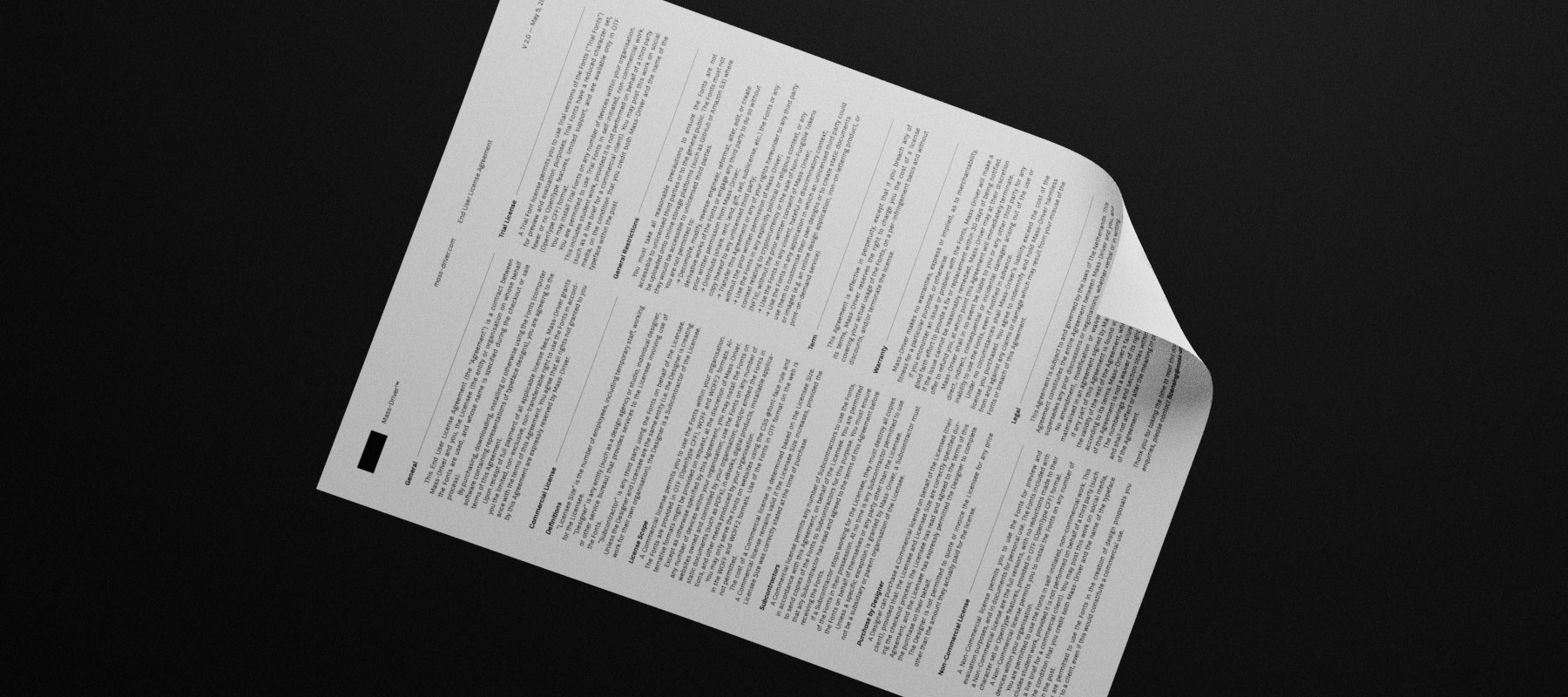Buying a font is harder than it should be. Navigating different license types, figuring out if you need a separate license for your client or design agency, and keeping track of how many installations or website visitors you’re allowed — it’s way too complicated. Add the fact that every foundry has a unique license agreement, with their own definitions and terms, and even the simplest licensing requirement can feel like a daunting problem.
This was never the intention. No type foundry wants to confuse you, it’s just difficult to move away from the ‘industry standard’ — and for the foundry, not without risk. But regardless, we think it’s necessary.

The Problem
The general standard that type foundries have fallen into is to separate licenses into categories for desktop, web, and so on. There’s some logic to this in theory: you don’t pay for webfonts unless you’re using them, or for app licensing if you don’t have an app. It’s paying for "only what you need". Except in practice, that isn’t so straightforward: a desktop font for a one-off project doesn’t cost less than one licensed as a long-term corporate workhorse. In most cases, separating file formats into multiple licenses just means projects spanning multiple formats are more expensive, and the whole process is more complicated. It also means that any project that doesn’t fit neatly into a predefined category is much harder to license.
And there’s a more fundamental issue with pricing fonts according to their usage, like the number of installations or website visitors: usage isn’t value. A 3-person design team in a 90-person company will almost certainly have a higher budget and a wider audience than a small, 3-person studio — in other words, they will be able to extract more value from the same fonts. Because of this, the traditional method of licensing fonts ends up on average over-charging smaller organisations relative to larger ones.
So with this in mind, we’ve spent a long time considering how the font licensing model could be improved. Since many current font buyers are already familiar with the way things work now, any alternative would need to be significantly simpler in order to justify switching. It would need to consider the grey areas of current technology, and most fundamentally, should have a pricing structure that’s more fair to smaller organisations.
The V2 Commercial License
Today we’re introducing the result of that consideration, the Mass-Driver V2 License. It’s designed to address as many of the current issues as possible: to be more fairly priced, to be versatile, and most of all, to be simple. The core of V2 is this: you buy a font, and then you can use it.

You buy a font: the price you or your client pays for a V2 license is based on the potential value they can gain from the font, rather than the number of actual users. This price is calculated according to just one metric — the size of the company licensing it.¹ This way, smaller companies pay less, and larger companies pay more, regardless of how many people are in the design department.
And then you can use it: once your company (or if you’re a designer, your client) has licensed a font, you can use it anywhere.² You can install the font on any computers your company has, use it on your website regardless of traffic, and share it with any subcontractors working for you. (If you’re a designer, this means you don’t need to buy anything: your client buys the license, and then you can use the relevant fonts in any work you do on their behalf.) If your design software lets you upload fonts to sync across devices, you can do that — and if you’re not sure where the line is between an app and a website, it doesn’t matter.
The V2 license is also truly perpetual. As long as it’s valid when you first buy it, the license remains valid forever. You don’t need to routinely check you’re still under the website traffic allowance, or pay for an upgrade when you hire more staff.
From today, our existing desktop, web, app, and other license types will be replaced by this single version, which we’re calling Commercial. It’s available directly through this site for individuals and organisations up to 100 employees — larger organisations can get in touch directly for more bespoke licensing.
The Non-Commercial License
As well as free trial fonts, which will continue to work as before, we’re also introducing a new option that sits in-between trials and the full license: Non-Commercial. This license is designed to fit any situations where the reduced character set of free trials isn’t enough, but you’re not actually using the fonts in a commercial context.
The NC license is priced at a flat rate, 20% of a single-user Commercial license, and includes the full desktop OTF files for you to use — in more extensive testing, in any non-commercial projects or student work, and also in pitches and design proposals you send to clients.³
The full terms of all three license options — Commercial, Non-Commercial and Trial — are available in the new V2 EULA. It’s one page, and we’ve made an effort to keep it as human-readable as possible. You can read the full V2 license here — if you have any questions about the terms or how they apply to your use case, please get in touch.
Today also marks the release of a new typeface from Mass-Driver: MD Primer.